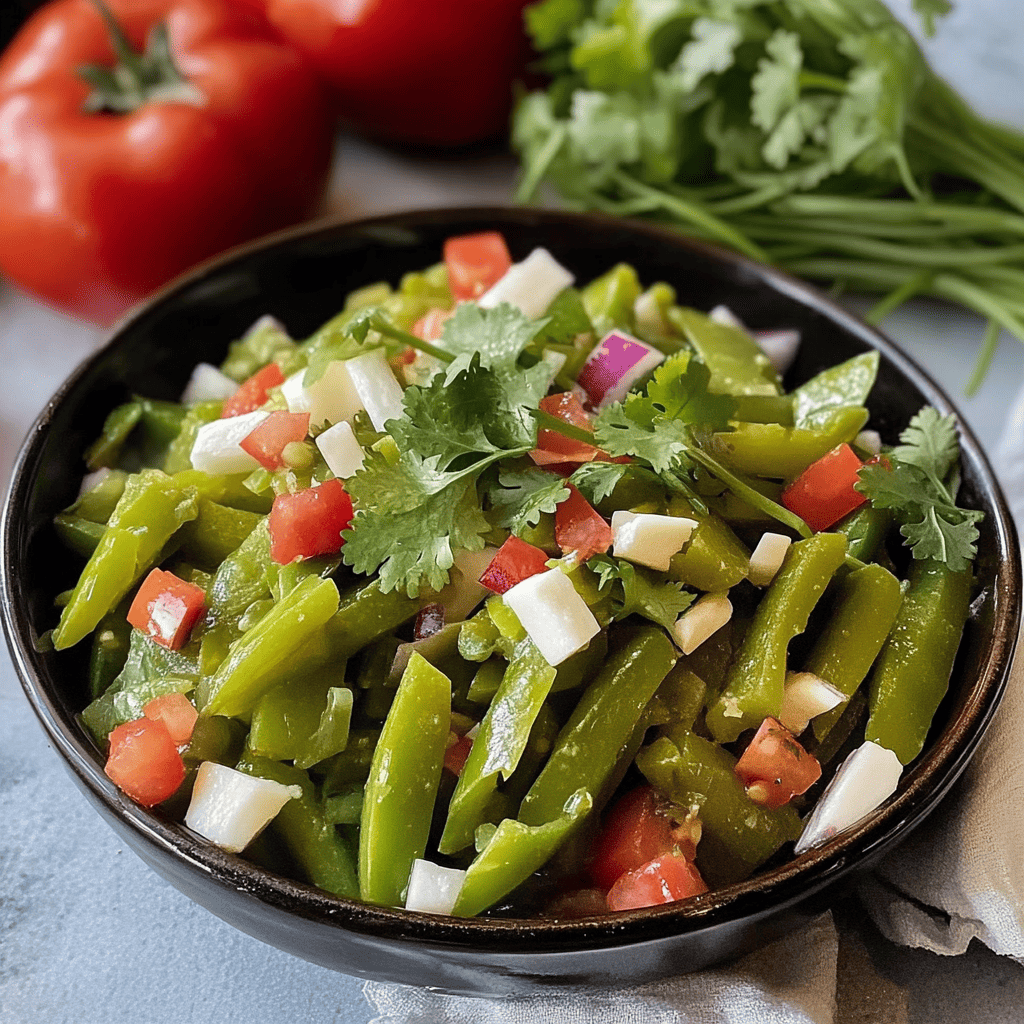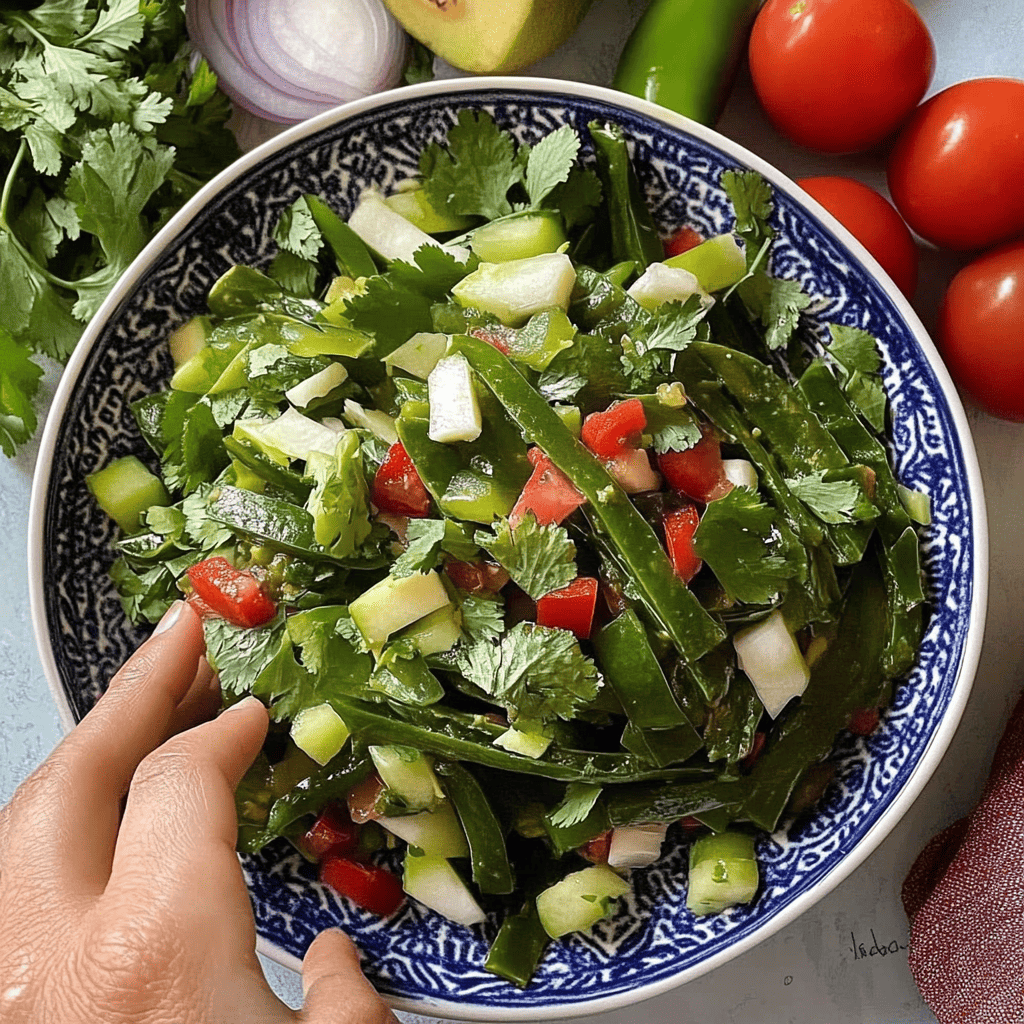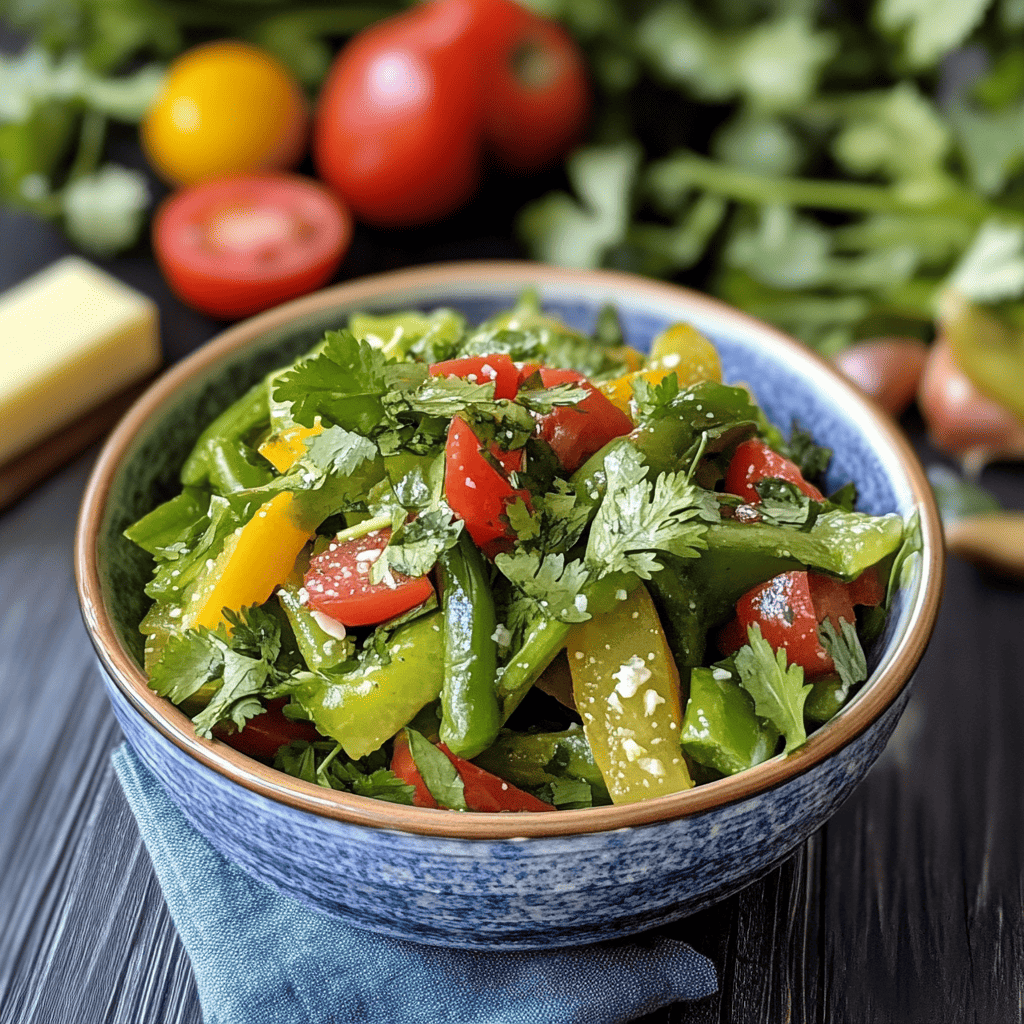Mexican Cactus Salad: A Healthy, Fresh, and Easy Treasure
Introduction
Immerse yourself in the richness of Mexican cuisine with a dish that embodies freshness, flavor, and tradition: Mexican Nopal Salad . This vibrant and nutritious dish is a culinary gem that stands out for its simplicity of preparation and complexity on the palate. Beyond its exotic main ingredient, the nopal (or prickly pear cactus), this salad is a symphony of textures and flavors that combine the acidity of the tomato, the freshness of the cilantro, the spicy touch of the serrano chile, and the smoothness of the avocado and queso fresco. Ideal for any time of day, from a light side dish to a refreshing main course, nopal salad is a healthy option that will transport you directly to the heart of Mexico.
Detailed History: The Nopal, Root and Heart of Mexican Cuisine
The history of the nopal cactus in the Mexican diet is as old as Mesoamerican civilization itself. The nopal cactus is not just a plant; it’s a national symbol, even featured on the Mexican flag’s coat of arms, where an eagle devours a snake atop a cactus. This image dates back to the Aztec legend of the founding of Tenochtitlán, their capital, on the site where they saw this sign.
Since pre-Hispanic times, the prickly pear cactus has been a staple food and source of sustenance for indigenous cultures. It was cultivated and harvested for its tender leaves (nopalitos), its fruits (tunas), and its medicinal properties. Ancient Mexicans not only consumed it for its flavor and nutritional value, but also used it to treat a variety of ailments, from digestive problems to skin diseases.
More Details on the History and Relevance of the Nopal
The versatility of the cactus in Mexican cuisine is astonishing. It’s used in countless dishes: roasted, boiled, in sauces, stews, soups, juices, and, of course, in salads. The most common way to prepare it is by boiling it to eliminate its “slime” or mucilage, a viscous characteristic that can be unpleasant for some palates. However, this slime, rich in soluble fiber, is precisely one of its most beneficial properties for health.
With the arrival of the Spanish, the cactus continued to be a staple food, and its consumption adapted to new techniques and ingredients. Cactus salad, as we know it today, is a testament to this culinary fusion. The incorporation of ingredients such as onion, cilantro, and queso fresco (introduced by the Spanish), along with avocado and tomato (native to the Americas), created a dish that faithfully reflects Mexico’s cultural fusion.
The popularity of cactus salad lies in its freshness and lightness. It’s a dish that feels healthy and nutritious, perfect as a side dish for heartier meals or as a refreshing option in hot weather. In traditional Mexican markets, it’s common to find stands selling pre-cooked and chopped cactus, ready to be transformed into this delicious salad, making it easy to prepare and a mainstay of the everyday Mexican diet. Cactus is not just a food; it’s a link to the land, history, and identity of Mexico.

Mexican Nopal Salad: Detailed Recipe
INGREDIENTS
To cook the nopales:
- 8 nopales stalks (tender, boneless)
- 1 piece of onion (about 1/4 of a medium onion)
- 3 sprigs of fresh cilantro
- 2 tomato peels (can be from red or green tomatoes; they help cut the slime of the cactus)
- Salt, to taste
For the salad:
- 3 ripe red tomatoes (red tomatoes), cut into small cubes or thin wedges
- 1/2 white or red onion, finely chopped or julienned
- 1 bunch of fresh cilantro, finely chopped
- 1 serrano chile, finely chopped (or to taste, removing the seeds if you want less heat)
- 1 medium avocado, cubed or wedged
- 1 medium fresh cheese (approximately 200-250g), cut into small cubes
- 1 bunch of radishes, washed and thinly sliced
- 2 tablespoons of apple cider vinegar
- 3 tablespoons of extra virgin olive oil
- 1 tsp dried oregano (preferably Mexican), crumbled
- Salt, to taste
- Freshly ground black pepper (optional, but recommended)
DETAILED PREPARATION
Step 1: Cook the Nopales (Crucial for the texture!)
- Cleaning the Nopales: Very carefully (you can wear gloves), clean the nopal leaves. Remove the spines with a sharp knife or vegetable peeler. If you buy them already cleaned, just wash them well under running water.
- Chop the Nopales: Once cleaned, chop the nopal leaves into small cubes or strips (sticks) of approximately 1-2 cm. Uniform sizing will help ensure even cooking.
- Cooking: In a large pot, place the chopped nopales. Add the onion, the 3 sprigs of cilantro, and the 2 tomato peels (these ingredients help cut the natural “slime” of the nopales). Pour in enough water to completely cover the nopales.
- Boil: Bring the pot to a boil over medium-high heat. Once boiling, reduce heat to medium and cook for 15-25 minutes, or until the nopales are tender but still firm, and the slime has almost completely disappeared. You’ll know they’re ready when they change from bright green to a more opaque green and the slime has significantly reduced.
- Drain and Rinse: Once cooked, pour the nopales into a colander. Rinse them under cold running water for a few minutes. This will help remove any remaining slime and slow the cooking process so they don’t become too soft. Drain well to remove all excess water. Let them cool completely.
Step 2: Prepare the Fresh Salad Ingredients
- Chop Tomatoes: Wash and chop the 3 tomatoes into small cubes or thin wedges, according to your preference.
- Chopping Onion: Finely chop half an onion (white or red) or cut it into very thin julienne strips. If the onion is very strong, you can soak it in cold water with a splash of vinegar for 5-10 minutes and then drain it well; this will soften its flavor.
- Chop Cilantro: Wash and finely chop the bunch of cilantro.
- Chop Serrano Chile: Wash and finely chop 1 serrano chile. If you prefer less heat, remove the seeds and white veins before chopping. If you don’t like the heat, you can omit it or use chopped pickled chiles for a different flavor.
- Slicing Radishes: Wash the bunch of radishes well and cut them into thin slices.
- Cutting Fresh Cheese: Cut the medium fresh cheese into small, uniform cubes.
- Prepare Avocado: Just before assembling the salad to prevent it from browning, cut the avocado into cubes or wedges.
Step 3: Assemble and Dress the Salad
- Combine Ingredients: In a large bowl, combine the cooked and drained nopales, chopped tomatoes, chopped onion, chopped cilantro, chopped serrano pepper, radish slices, and fresh cheese cubes.
- Prepare the Dressing: In a small bowl, combine the apple cider vinegar, extra-virgin olive oil, crumbled dried oregano, and salt. You can add a little freshly ground black pepper if desired. Whisk well with a fork until the dressing is emulsified.
- Dressing the Salad: Pour the dressing over the cactus and vegetable mixture in the bowl. Using a large spoon or spatula, gently mix all the ingredients together so the dressing is evenly distributed.
- Add Avocado: Finally, add the avocado cubes or wedges. Mix very carefully to avoid breaking up the avocado.
- Adjust Seasoning: Taste the salad and adjust the salt if necessary.
- Serving: Serve the fresh Mexican cactus salad immediately. It’s ideal as a side dish or as a light main dish.
Estimated Preparation Time
- Active preparation time: 25-30 minutes (clean, chop, cook nopales, chop vegetables)
- Cooking time for nopales: 15-25 minutes
- Cooling time for nopales: 10-15 minutes
- Estimated total time: 50-70 minutes
Additional Tips
- Fresh vs. Canned Nopales: While canned nopales are a quick option, I highly recommend using fresh nopales. The flavor and texture are unmatched. If you use canned nopales, be sure to rinse them thoroughly to remove the liquid.
- Cutting the Slime: Tomato skins (green or red tomatoes) are a traditional trick for reducing the slime on nopales. You can also add a piece of onion skin (the first dry layer) or a pinch of baking soda to the cooking water. However, the slime is rich in fiber; if it doesn’t bother you, it’s not necessary to remove it completely.
- Mexican Oregano: Mexican oregano has a more citrusy and earthy flavor than Mediterranean oregano. If you can find it, use it for a more authentic flavor.
- Chili to Taste: Serrano chili is spicy. If you’re not a fan of heat, you can omit it or use a milder jalapeño.
- Cheese Variations: If you can’t find fresh cheese, you can substitute it with cottage cheese or panela cheese, or even feta cheese for a different, saltier touch.
- Additional Protein: For a more complete meal, you can add shredded chicken, drained canned tuna, cooked black beans, or chickpeas to the salad.
- Storage: This salad is best enjoyed fresh. If preparing it in advance, add the avocado just before serving to prevent browning. It will keep well in the refrigerator for 1-2 days in an airtight container.

Frequently Asked Questions
- Is cactus slime bad for you? No, cactus slime (mucilage) is actually very beneficial. It’s a soluble fiber that aids digestion, can help control blood sugar levels, and lower cholesterol. Although its texture isn’t to everyone’s taste, it’s not harmful.
- Can I use pre-cooked nopales? Yes, many Mexican markets sell pre-cooked and pre-chopped nopales. This significantly reduces preparation time. Just be sure to rinse them well before using.
- What can I use instead of apple cider vinegar? You can use fresh lemon or lime juice to add acidity to the dressing.
- Is it vegan-friendly? The original recipe uses fresh cheese. To make it vegan, simply omit the cheese or substitute it with a nut-based vegan cheese or pressed and marinated firm tofu.
- How do I know if the nopales are cooked? Nopales are cooked when they are tender when pierced with a fork and have lost much of their mucus (slime). Their color will also change to a duller green.
Texture and Flavor
The Mexican Nopal Salad is a feast of textures and flavors that play in harmony:
- Texture: Cooked nopal has a slightly meaty yet tender texture , with a soft, distinctive bite. Tomatoes contribute a mild juiciness , while finely diced onion adds a light crunch and a hint of heat. Cilantro contributes a grassy freshness . Serrano chile, when used, adds a crunchy, spicy note . Radishes offer a vibrant crunch and an earthy, spicy kick. The avocado is creamy and smooth , contrasting with the elastic firmness of the queso fresco .
- Flavor: The overall flavor is fresh, vibrant, and balanced . The prickly pear cactus has a slightly earthy, vegetal flavor , which is a great canvas for the other ingredients. The tomato brings a tangy sweetness , the onion a pungency , and the cilantro a bright, grassy note . The serrano pepper adds a spicy heat that awakens the palate. The avocado offers a buttery richness and a mild, nutty flavor, while the queso fresco contributes a milky saltiness and a pleasant smoothness. The apple cider vinegar and olive oil dressing, along with the oregano, adds a refreshing acidity and a herbal aroma that ties all the flavors together. It’s a dish that feels clean, refreshing, and full of life .
Consumer Context
- Versatile Side Dish: It is the ideal accompaniment to grilled meats, grilled chicken, tacos, tostadas or any Mexican main dish.
- Light Main Course: On its own, especially with extra protein, this is a light and nutritious meal, perfect for a healthy lunch or dinner.
- Antojito or Botana: It can be served as a healthy “botana” (appetizer) at gatherings, accompanied by tortilla chips or crackers.
- Warm Days: Its freshness makes it the perfect option for cooling off in hot climates.
- Healthy Diet: It is an excellent addition to any healthy diet due to its high fiber, vitamin and mineral content, and low calorie content.
Visual Aspect
The Mexican Nopal Salad is visually very attractive, an explosion of colors that invites you to taste it:
- Color Palette: The intense green of the cactus and cilantro predominates , contrasted by the bright red of the tomatoes and radishes . The pale greenish yellow of the avocado and the pure white of the fresh cheese and onion complete a colorful and appetizing composition.
- Visual Texture: The salad has a moist, juicy appearance thanks to the dressing and fresh vegetables. The different shapes of the chopped ingredients (cubes, strips, slices) are visible, adding visual interest.
- Volume and Freshness: It presents a generous volume, giving the impression of a fresh and abundant salad. The shine of the olive oil on the vegetables highlights the freshness.
- Presentation: It’s usually served in a large bowl, where the colors blend harmoniously. An extra sprinkle of chopped cilantro or a few slices of radish on top can further enhance its visual appeal.
Curiosities
- The Nopal on the Flag: As mentioned, the nopal is a national symbol of Mexico, present on the shield of the Mexican flag alongside the eagle and the serpent, symbolizing the founding of Tenochtitlán.
- Medicinal Properties: The nopal has been used in traditional Mexican medicine for a variety of purposes, including controlling diabetes and cholesterol, thanks to its high fiber content.
- A Forgotten “Superfood”: Before the popularity of goji berries and chia, the nopal cactus was already a superfood for pre-Hispanic cultures, valued for its nutritional density.
- Nopal Varieties: There are many varieties of nopal. For human consumption, the tender leaves of specific varieties are usually used, as they have fewer spines and are softer.
- Prickly Pear Growing: The prickly pear is a hardy and adaptable plant that can grow in arid climates, making it a sustainable growing option in many regions.
Nutritional Value (Estimated per Serving)
- Considerations: Nutritional value is an estimate and may vary depending on the exact size of the ingredients, the amount of oil and cheese, and whether additional protein is added. This estimate is based on approximately 4-6 servings.
- Suggested Serving: Approximately 1/4 or 1/6 of the total recipe.
- Calories: 180-250 kcal
- Protein: 8-12g (mainly from cheese)
- Total Fat: 12-18g (mainly from avocado and olive oil)
- Saturated Fat: 3-5g
- Carbohydrates: 10-15g
- Fiber: 5-8g (very high due to the nopal and vegetables)
- Sugars: 3-6g (natural from vegetables)
- Sodium: 200-400mg (depending on added salt and cheese)
- Cholesterol: 20-40mg (from cheese)
Additional Benefits and Interesting Facts
- Rich in Fiber: Nopal is exceptionally rich in soluble and insoluble fiber, which aids digestion, helps regulate glucose and cholesterol levels, and contributes to satiety.
- Low in Calories: Despite being so nutritious, cactus salad is relatively low in calories, making it ideal for weight control.
- Source of Vitamins and Minerals: Provides Vitamin C (tomato, radishes), Vitamin K (nopal, cilantro), Calcium (nopal, cheese), Potassium (nopal, avocado) and Magnesium.
- Antioxidant Properties: Nopales and fresh vegetables are rich in antioxidants that fight free radical damage in the body.
- Hydrating: With its high water content, this salad contributes to the hydration of the body.
- Dietary Versatility: It is naturally gluten-free and can be easily adapted to be vegan (by omitting the cheese) or low-carb.
Other Information
- Availability: Fresh nopales are commonly found in Latin American markets or specialty grocery stores. If you can’t find them, canned or jarred nopales are an alternative, although the flavor and texture may vary.
- Safety: When handling fresh nopales, be careful of the small spines (glochids) that can become embedded in the skin. Use gloves or tweezers if necessary.
- Adapt to Your Taste: The beauty of this salad lies in its flexibility. Adjust the ingredients and quantities to suit your personal taste.

Conclusion
Mexican Nopal Salad is a testament to the simplicity and richness of Mexican cuisine. It’s a dish that not only delights the palate with its explosion of fresh flavors and contrasting textures, but also nourishes the body with an abundance of fiber, vitamins, and minerals. Beyond being a recipe, it’s a window into the tradition and cultural roots of the nopal, an ingredient that has been at the heart of the Mexican diet for millennia. Easy to prepare and adaptable to a variety of preferences, this salad is the perfect option for those seeking a healthy, refreshing, and authentic meal. We encourage you to venture out and prepare this salad at home and discover why nopal salad is a true Mexican culinary treasure. Enjoy!

